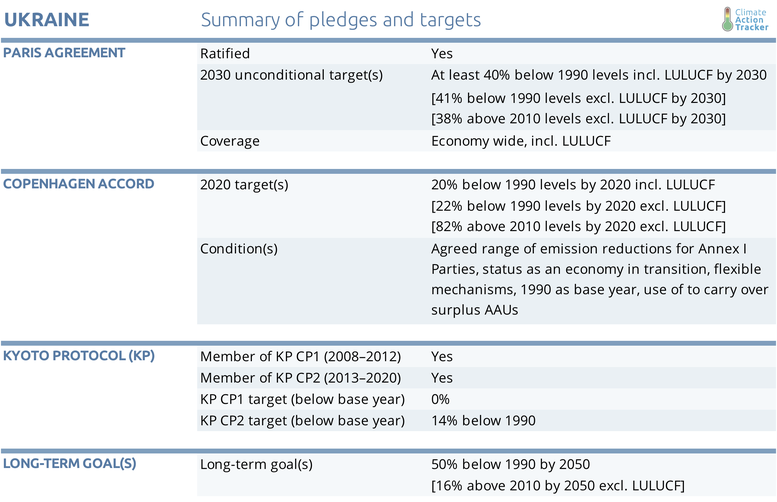Pledges And Targets
Summary Table

Paris Agreement targets
Ukraine ratified the Paris Agreement on 19 September 2016.
Ukraine’s Nationally Determined Contribution (NDC) (Government of Ukraine, 2015) includes a target of reducing GHG emissions by at least 40% below 1990 levels, incl. LULUCF, by 2030. Assuming that Ukraine’s LULUCF sink remains at the average level over the period 2007–2016 (-28 MtCO2e), this NDC translates to an emissions level of up to562 MtCO2e excl. LULUCF in 2030 (equivalent to 41% below 1990 levels excl. LULUCF). However, the most recent historical data from 2016 shows that emissions excl. LULUCF have already declined by 69% below 1990 levels.
The NDC indicates that “an approach to including the land use, land-use change and forestry in the climate change mitigation structure will be defined as soon as technical opportunities emerge, but no later than 2020.”
Ukraine has not yet defined which LULUCF accounting method it will adopt. For simplicity, and in the absence of other information, this assessment shows the target level excluding LULUCF by subtracting the projected LULUCF sink from the target level incl. LULUCF for 2030. However, it should be noted that if Ukraine was to choose an approach based on Kyoto accounting (limited gross-net) similar to that which the EU is indicating it may choose, it could obtain significant credits, which would increase the level of allowed GHG emissions excluding LULUCF in 2030 by 28 MtCO2e/yr. The size of Ukraine’s removals from the LULUCF sector has declined over the period from 1990–2014. From this trend, LULUCF removals are expected to have a minor impact in the future.
Ukraine has stated that it will actively participate in current and future international market mechanisms and its current emission reduction target does not take these market mechanisms into account.
Ukraine has indicated that its NDC will be “revised after the restoration of its territorial integrity and state sovereignty as well as after the approval of post-2020 socio-economic development strategies with account of investment mobilization.” In this revision, Ukraine should elaborate on its intended accounting to take into account LULUCF emissions and international market mechanisms. This would improve the transparency of its target and enable clearer comparisons with other NDCs.
Since Ukraine is expected to reach its NDC under the current policies scenario and to overachieve its NDC under the planned policies scenario, we would expect Ukraine to update its NDC in the near future.
2020 pledge and Kyoto Protocol
Ukraine submitted a QELRO1 (Quantified Emission Limitation or Reduction Objective) level of 76% of base year emissions for the second commitment period of the Kyoto Protocol. This represents a 14% reduction of average annual emissions in the period of 2013 to 2020 compared to the 1990 base year. The target is conditional on full carry-over and, to directly quote the Government, no "cancellation or any limitation on use of this legitimately acquired sovereign property."
The Doha Amendment limited targets for the second commitment period to the average historical emissions 2008–2010.2 Ukraine is the country most affected by this rule, which leads to a Kyoto pathway almost 300 MtCO2e/yr lower than the direct translation of their target for the period 2012–2020. Ukraine has not yet ratified the Doha Amendment.3
In addition, under the Copenhagen Accord, Ukraine has pledged to reduce emissions by 20% below 1990 levels incl. LULUCF by 2020 (22% below 1990 levels excl. LULUCF by 2020) (Government of Ukraine, 2010). The pledge emissions level represents an increase of 111% on 2014 levels excl. LULUCF. Under the current policy projection, Ukraine will easily meet this target: the target is 82–94% higher than the projected emissions in 2020 excl. LULUCF. Ukraine’s Copenhagen Pledge is conditional and based on a number of different factors: an agreed range of emissions reductions for Annex I parties, Ukraine’s status as an economy in transition, the flexible mechanisms, 1990 as base year, and to be allowed to continue to carry over surplus AAUs (Article 3.13).
1 | The QELRO, expressed as a percentage in relation to a base year, denotes the average level of emissions that an Annex B Party could emit on an annual basis during a given commitment period
2 | This is part of the Doha decisions which constitutes part of the amendments to the Kyoto Protocol. Amendments only come into effect once they are ratified by Parties.
3 | List of parties that adopted the Doha Amendment to the Kyoto Protocol as of 28 September, 2017.
Long-term goal
For 2050, Ukraine has proposed an emissions reduction target of 50% below 1990 levels (State Environmental Investment Agency of Ukraine, 2014).
Further analysis
Latest publications
Stay informed
Subscribe to our newsletter




